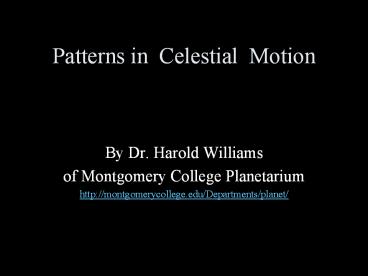Patterns in Celestial Motion - PowerPoint PPT Presentation
1 / 21
Title:
Patterns in Celestial Motion
Description:
Title: The REAL OCCULT: Author: Harold Williams Last modified by: Harold Williams Created Date: 11/8/2003 6:41:19 PM Document presentation format – PowerPoint PPT presentation
Number of Views:129
Avg rating:3.0/5.0
Title: Patterns in Celestial Motion
1
Patterns in Celestial Motion
- By Dr. Harold Williams
- of Montgomery College Planetarium
- http//montgomerycollege.edu/Departments/planet/
2
Time counting repeating patternsin the sky
- A second, 1/60 of a minute, 1/(246060)1/86,400
of a day - A minute, 1/60 of a hour, 1/(2460)1/1440 of a
day - A hour, 1/24 of a day
- DAY, originally from sun rise to sun rise or sun
down to sun down, now a rotation of the earth
about its axis - A week, Jewish bundling of days, sacred calendars
- MONTH originally a lunation (same moon to
identical moon) - YEAR originally a revolution of the sun around
the earth through the ecliptic, now a repeat of
the earth around sun in its orbit. - A decade, century, millennium different bundling
of years - PRECESSION CYCLE originally motion of the first
day of a season around the ecliptic, now cycle of
the rotation axis (day and night axis) about the
year axis (this angle is around 23 ½ degrees now
and takes around 26,000 years) - GALACTIC YEAR revolution of solar system about
the Galactic center in an orbit of around 250
million years.
3
Day and Night most basic, what you see every day,
without going into outer space!
4
From outer space since 300BCE
5
First of all earth is round
- It looks flat locally to me and you.
- Aristotle, shadow of the earth on the moon during
a lunar eclipse is always round. - Greek sailors observed that when ships left the
harbor the top of the mast disappeared last and
the bottom of the ship first. So the earth is
definitely curved. - But does the central fire, the sun, move around
the earth or the earth rotate.
6
History and Social Studies is very important in
Science (Aerospace)
- Evolution of models to explain things over time.
- You really cant understand day and night motion
without folding in yearly motion particularly
when you start observing the changes in the night
sky through out the year. This started a long
time ago. - Language, reading and writing are essential.
- Mathematics, the self consistent abstraction of
reality is very useful.
7
Celestial Sphere
8
Celestial sphere on Latitude Protractor
9
Celestial Sphere Rectified forthe North Pole
10
Celestial Sphere Rectified forthe Equator
11
Celestial Sphere Rectified forthe some place
like here
12
The Celestial Sphere
0
- Zenith Point on the celestial sphere directly
overhead - Nadir Point on the c.s. directly underneath
(not visible!) - Celestial equator projection of Earths equator
onto the c.s. - North celestial pole projection of Earths
north pole onto the c.s.
13
The Celestial Sphere (II)
0
- From geographic latitude l (northern hemisphere),
you see the celestial north pole l degrees above
the horizon - From geographic latitude - l (southern
hemisphere), you see the celestial south pole l
degrees above the horizon.
90o - l
l
- Celestial equator culminates 90o l above the
horizon.
14
Night Time Star Motion
15
Round Earth Rotating now
16
Putting DAY and YEARtogether the modern way
17
The Annual Motion of the sun
0
Due to Earths revolution around the sun, the sun
appears to move through the zodiacal
constellations. The suns apparent path on the
sky is called the ecliptic. Equivalent The
ecliptic is the projection of Earths orbit onto
the celestial sphere.
18
The Seasons (IV)
0
Earths orbit (eccentricity greatly exaggerated)
Earth in January
Earth in July
sun
Earths distance from the sun has only a very
minor influence on seasonal temperature
variations.
19
The Motion of the Planets (I)
0
- The planets are orbiting the sun almost exactly
in the plane of the ecliptic.
Jupiter
Venus
Mars
Earth
Mercury
The moon is orbiting Earth in almost the same
plane (ecliptic).
Saturn
20
Precession
21
(No Transcript)































